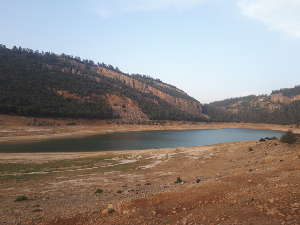Using AI to control energy for indoor agriculture
30 September 2024
Published online 13 December 2022
The impacts of climate change are exacerbating biodiversity loss in the MENA region, with scientists calling for more research.
Imad Cherkaoui
Morocco has been crippled by drought for more than four years, which has seen wetlands dry up. Cherkaoui says birds have changed their migration behaviour and are no longer wintering in Morocco, opting instead for northern Spain or southern France.
This change is illustrative of biodiversity impacts across the Middle East and North Africa (MENA). As climate change — considered one of the key drivers of biodiversity loss — intensifies, effects on the region’s wildlife, plants and other species are expected to increase.
Large knowledge gaps
Despite the important link between climate change and biodiversity loss, researchers say not enough is known about the relationship between the two in the MENA region, and that more focus is needed on this issue. “There are still big knowledge gaps in terms of how biodiversity is trying to adapt to climate change, and how it is affected by it,” says Cherkaoui. “There is a serious need for more research.”
Biodiversity, essential to the processes that support life on Earth, also influences resilience, or vulnerability, to climate change, and contributes to mitigation and adaptation. Healthy wetlands and forests, for example, function as carbon sinks that pull carbon dioxide from the atmosphere, while intact mangroves help protect coastlines from flooding and storm surges.
Imad Cherkaoui
Even though it’s the driest area in the world, the MENA region is home to diverse terrestrial, freshwater and marine ecosystems — deserts, steppes, mountains, broadleaf and coniferous forests, wetlands, coral reefs and mangroves, among others. The rich biodiversity found in these ecosystems is under immense pressure from human activities, including habitat loss due to intensive agriculture, urbanization, industrial development and dam construction; overexploitation of water, plant and animal resources; and pollution.
Climate change is aggravating these pressures, increasing the intensity and frequency of wildfires, storms, and periods of drought, while rising temperatures and decreasing water availability are forcing species to shift their ranges to adapt, explains Hany El-Shaer, regional director of the International Union for the Conservation of Nature’s (IUCN) West Asia office in Amman, Jordan. Across the region, “climate change is becoming increasingly to blame for the reduction of biodiversity,” he says.
Impacts from west to east
In Morocco, Cherkauoi says climate change has exacerbated the drying of wetlands — more than 80% in the Middle Atlas are completely dry — caused largely by the misuse and overexploitation of water for intensive agriculture. While migratory birds can seek water, food and shelter elsewhere, species that cannot fly, like otters and freshwater fish, cannot, and their populations are shrinking. “Wetland-dependent biodiversity is very vulnerable to climate change,” he says.
In southern Iraq, the once vast marshlands, previously one of the most important waterfowl areas in MENA, have also dried up. Drought and extreme temperatures that scientists link to climate change have intensified shortages caused by decades of water mismanagement and reduced river flows due to upstream dams, leading to the marshlands’ desiccation. Scientists say this could lead to the global extinction of the endemic smooth-coated otter, and the local extirpation of birds like the sacred ibis, pygmy cormorant and goliath heron. The drying of the marshlands is also thought to have reduced the number of migratory and wintering birds.
In Morocco, birds that previously never lived above 2,000 metres, like the African crimson-winged finch and white-throated dipper, can now be found as high 3,000 metres. Changes are being seen in vegetation too. Atlas cedars, native to Morocco and Algeria, are trying to shift to higher altitudes, a form of adaptation to drought and higher temperatures.
In the mountains of northern Iraq’s Kurdistan Region, there is mounting evidence of the impacts of drought and climate change on biodiversity, says Korsh Ararat, assistant lecturer in biology at the University of Sulaimani in the Kurdistan Region of north-eastern Iraq. “Mammals and birds are searching for water, especially during the summer,” he says. Ararat was recently involved in collecting data for a forthcoming research paper on how climate change will impact Persian leopard distribution in the Kurdistan Region. Other studies have shown leopards have moved further up mountains to escape hotter temperatures.
More efforts needed

Imad Cherkaoui
El-Shaer blames the lack of biodiversity-related research on the region’s political conflicts, wars, economic woes and poverty. “Countries are focusing on human needs and fighting poverty,” he says.
The IUCN Red List, the most comprehensive inventory of species’ conservation status worldwide, contains some data for all MENA countries. But El-Shaer says the number of regional species evaluated by the Red List programme is not enough, and more research is needed regionally on ecosystem services and restoration.
Cherkaoui says it’s important to investigate solutions and adaptation measures that could increase the resilience of ecosystems, given biodiversity’s potential to reduce the negative impacts of climate change.
For countries like Iraq, it will first be necessary to get more students interested in pursuing the fields of biology, ecology and conservation to improve environmental research capacity. “Since I started teaching, I always tell my students there are great opportunities for careers and research in environmental sciences,” says Ararat.
doi:10.1038/nmiddleeast.2022.79
Stay connected: